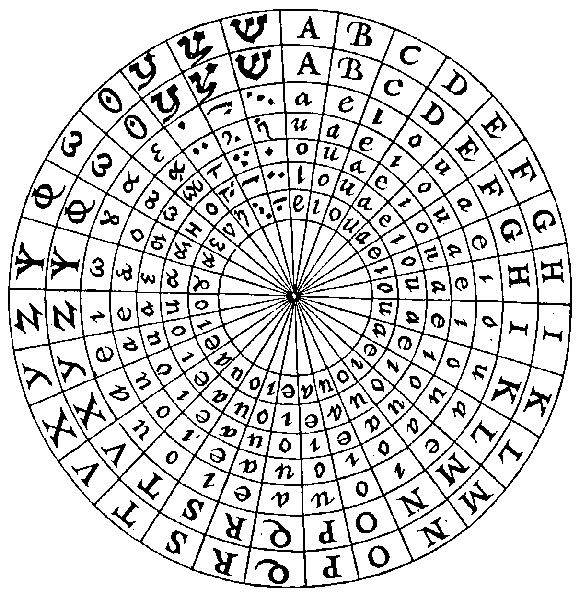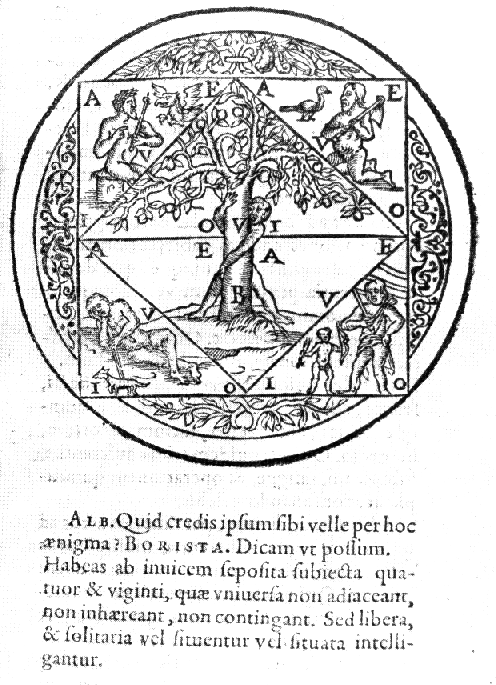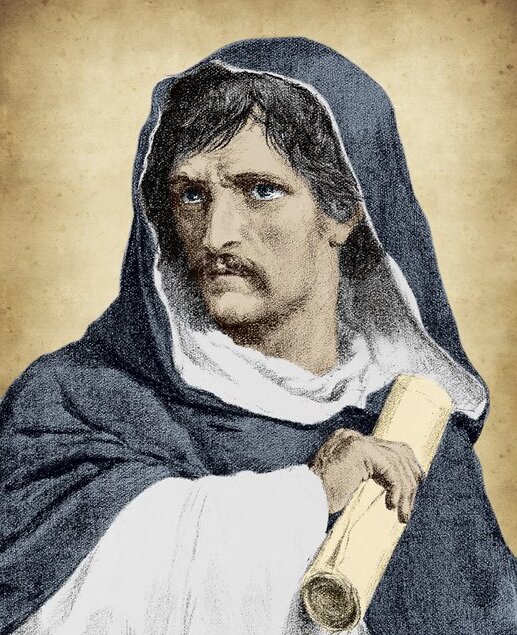We try to decipher the codes of Giordano Bruno, and especially the arts of memory presented in his books. Somehow he managed to combine in one text quite a lot: PAO-like visual cues, healing visualization, geometric formulas, almost kabbalistic text manipulations and mystical practice now lost. I will not try to analyze the original texts, although I have them in Latin on my computer with some common interpretations. Instead, I will present my personal “lessons learned”. If you are interested in a simple method you can borrow from Giordano Bruno, please check https://www.keytostudy.com/planetary-memory-structures/.
Everything is interconnected
In our age of science and technology, we try to sort all human knowledge into very few categories, which in turn splits into further categories. We create mind maps almost instinctively as a way to organize information. This is very effective for quick processing, but for deeper insights, it is possible to consider information laterally as interconnected circles.
Every aspect in the inner part of our mindmaps can be matched with something on the outer map, generating surprising results. To facilitate this creative exercise, it is better to use shallow mind maps with branches marked by letters in alphabets and arranged in circles. Once we generate various superpositions of circles, we can create new unexpected ideas.
This creativity exercise is very powerful and can be learned quickly. The hardest thing to do is organize shallow mind maps. We are not used to addressing dozens of possibilities each time we make a selection.
Multiple representations
Everything worth thinking about can be presented from multiple perspectives and each perspective has a different set of attributes. Simply choosing a certain perspective, we take upon ourselves some of the attributes. This can be a very powerful reframing exercise.
Medieval literature goes in great depth discussing healing exercises when the healing is performed by focusing on certain perspectives of planets and substances. The visualization is enhanced by consideration of the textures and colors characteristic to the healing substances.
Today we use similar principles homeopathic medicine and NLP. Giordano Bruno wrote seven descriptions for seven planets that can serve for healing meditation and visualization. Quite often I am asked about the best way to improve visualization skills. Why not visualize these seven representations of seven planets?
Beyond PAO
We often use a chunk of person – action – object to describe three words worth visualization and memorization. This is the basic chunk we place in our mental palaces. The medieval tradition also used mental palaces, when each part of a church served as a room in a mental palace. Only the visualizations were not limited to PAO. In some places, we read about seven circles corresponding to seven words that can be connected to one visualization.
So PAO is a person performing an action with an object. Now we can put a person on an animal and generate a second PAO for the beast. Then we can focus on the face of the person, and generate further cues or details for it. There are some examples of these compound markers in the seven planetary images. I quote:
The Seven Images of Mars
- The First Image of Mars is a Man armored and riding upon a Lion upon whose Helm a Vulture strikes with its beak. He is a Man of the most ferocious appearance.
- Second: A Man armed with Broad-Sword and Spear upon whose Helm is a form resembling a Chimaera from whose mouth shoots sparkling flames.
- Third: One who casts sulfurous Fire with his right hand, having taken hold with his left of the neck of a Leopard which he rides against its will.
- Fourth: A Man having in his right hand a Sword unsheathed and dripping with blood and in his left a human Head whose countenance is burnt as if by the sun.
- Fifth: A Man of tawny coloring riding upon a Wolf, dressed in Red garments and bearing a heavy Scepter of Iron.
- Sixth: A ravished and very beautiful Virgin before a Man who turns away from her: they are together in an Ivory-White Chariot drawn by two Dog-Headed Apes.
- Seventh: A Leopard and a Tiger fighting, on both sides are two helmeted men threatening each other with drawn Swords.
Using letters for ideas
There is nothing new about it, only today’s major systems encode a single digit in a letter. Medieval scholars could encode multiple digits in a single letter.
The western alphabet is not rich enough to encode multiple digits, so multiple alphabets can be combined. Each letter or a number may correspond to a complex idea. Then we can start placing letters on geometric shapes, adding visual cues to remember which idea is represented by the letters.
This method can be wonderfully mathematical and geometrically complex in 2D representation. We can actually share our mnemonic guides with others, who understand the way we creat visualization and at the same time obfuscate it from people who are not familiar with our visual dictionaries.
Ancient roots to modern ideas
It is a wonderful experience to discover the roots of the methods I commonly use in ancient texts. I feel a sort of tradition that encompasses ages.
Eventually, this tradition was eradicated by the church. Why? Because of the emotional impact carried by the particular visualizations. They did not reference the common imagery of the time but connected in complex ways with yet more ancient Egyptian magic.
A very different representation of the same ideas is the Pythagorean tradition, which may be considered the basis of modern music. The seven musical notes may be visualized using the visualizations of seven planets. I am not sure to what extent this is useful, but it is definitely inspiring. We also know that musicians are very good both in memory tasks and in multitasking. A coincidence? Perhaps.
We do not have so much patience
Simply generating and manipulating so many images at the same time requires focus levels beyond what most of us can master today. We feel quite well with 3 or 5 possibilities, and a bit worse with 9. The number 7 was for decades considered as the size of our working memory, but the actual number is probably different and task-dependent.
Considering 7×7 possibilities at the same time is very hard for us. And doing this for 7 concentric circles is even harder. If the medieval masters could apparently do this, so can we. I cannot really imagine how much patience and focus are required to master this skill. Perhaps 7 years of hard work? That would be appropriate.
The secrets are lost
I do not really understand these mystic texts. It is not clear if they are more effective than simpler alternatives. This does not mean I cannot get inspired by them. The original texts are a great exercise in critical thinking and creativity, even if it is essentially futile.
Giordano Bruno books
Bruno of Italy, an Italian philosopher and mathematician of the 16th century, left behind a rich literary legacy that continues to captivate readers today. Books by Giordano Bruno encompass a wide range of topics, reflecting his bold and controversial ideas. In “The Ash Wednesday Supper,” Bruno explored the nature of the universe, arguing for an infinite cosmos with countless worlds and denying the Earth’s central position. “On the Infinite Universe and Worlds” further expanded on these concepts, challenging conventional beliefs and advocating for a boundless universe filled with life. Bruno’s magnum opus, “The Heroic Frenzies,” delved into mystical and metaphysical themes, intertwining philosophy, mythology, and poetry. Despite facing persecution for his ideas, Bruno’s writings remain influential in shaping our understanding of the cosmos and our place within it.
What was Giordano Bruno famous for?
Giordano Bruno was famous for his revolutionary ideas and controversial beliefs during the Renaissance. He was an Italian philosopher, mathematician, and astronomer who proposed that the universe was infinite and that it contained countless other worlds. Bruno also challenged prevailing religious doctrines, advocating for a more expansive view of the cosmos. His unorthodox ideas led to his persecution by the Inquisition, and he was ultimately burned at the stake when he was 52 years old.
What were Giordano Bruno’s last words?
Giordano Bruno’s death was a tragic event in 17th-century Italy. Accused of heresy, he was burned at the stake for his radical beliefs in science, cosmology, and the infinite universe. His defiance and sacrifice continue to inspire seekers of knowledge and champions of intellectual freedom.
Giordano Bruno was burned at the stake on February 17, 1600, for his controversial beliefs. His last words reportedly were: “Perchance you pronounce this sentence against me with greater fear than I receive it.” Despite his tragic fate, Giordano Bruno’s ideas on cosmology and the infinite nature of the universe have had a lasting impact on scientific and philosophical thought.
His works had a profound influence on the development of modern science and philosophy. One notable Giordano Bruno statue is located in Rome, Italy. The statue is situated in the Campo de’ Fiori square, where Bruno was executed. Created by sculptor Ettore Ferrari, the statue was erected in 1889 to commemorate Bruno’s life and his contribution to science and philosophy.
What did Giordano Bruno believe in?
Bruno Giordano proposed the existence of an infinite universe with multiple worlds and suns, challenging the prevailing geocentric model. Bruno also explored the concept of pantheism, seeing God as immanent in nature. He embraced the Hermetic tradition, which combined elements of ancient Egyptian and Greek philosophy, alchemy, and magic.
Giordano Bruno believed in a pantheistic view of God, considering God to be present in all things. While he acknowledged Jesus as a significant figure, he questioned the dogmas of the Christian faith, including the divinity of Jesus. Bruno’s unorthodox beliefs led to his conflict with the Roman Catholic Church, resulting in his eventual execution.
Giordano Bruno Quotes
“Doubt is the beginning of wisdom.”
“If the butterfly wings its way to the sweet light that attracts it, it’s only because it doesn’t know that the fire can consume it.”
“The Divine Light is always in man, presenting itself to the senses and to the comprehension, but man rejects it.”
“It’s a poor mind that would think with the multitude, because it is multitude. Truth is not altered by the opinions of the vulgar, or by confirmations of the many”
“Time is the father of truth, its mother is our mind”
Are you curious about tapping into your memory’s potential using some cutting-edge techniques inspired by ancient memory methods? Check out my Memory Masterclass . You do not have to pay the full price. Contact [email protected] and ask for a deep discount. Keep in mind, though, this is an advanced course, so having some basic memory training beforehand would be beneficial.

Get 4 Free Sample Chapters of the Key To Study Book
Get access to advanced training, and a selection of free apps to train your reading speed and visual memory



